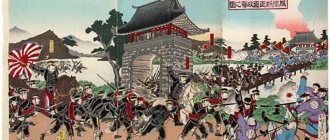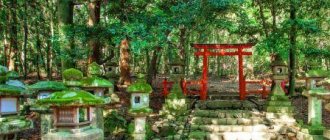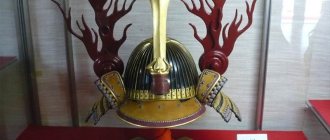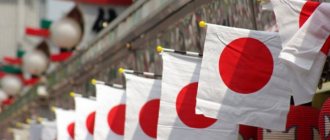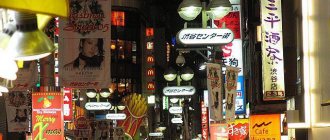Contrary to popular belief, samurai did not disdain teppo (that is, firearms) as an inappropriate and “vile” weapon. More precisely, those who followed tradition and refused gunpowder quickly lost to those who rained lead on the enemy. The Japanese feudal lords loved the new method of eliminating opponents so much that they began truly mass production of arquebuses. Soon their number in this country alone exceeded the number of firearms in all of Europe. And, as is often the case with the Japanese, they have achieved mastery in production. The examples of teppo that have come down to us are real works of art, poetry made of iron, wood, and often gold.
The Japanese word "teppo" refers to an entire class of weapons. Initially, this was the name given to arquebuses of the Portuguese type, which came to the country with the beginning of trade. But since Japanese craftsmen began making gunpowder weapons, its evolution here has followed its own unique path. Over hundreds of years, teppo has acquired its own style and even other functions. Japanese arquebuses became more massive than European ones, and the popularity of hand cannons, kakae-zutsu, generally made local firearms a unique phenomenon.
Tanegashima Samurai Musket
Tanegashima is both the Japanese version of the arquebus and the name of the island where trade was carried out with the Portuguese. The weapons adopted from Europeans in the 16th century were initially made according to Western models, but soon Japan developed its own school of artisans and the philosophy of teppo. Perhaps due to the poor quality of iron and gunpowder, local arquebuses became more massive and large-caliber.
Tanegashima in action. This massive monster looks somewhere on the border between an arquebus and a hand cannon:
Standard teppo of the Japanese feudal army:
Weapons in Japan
Elena Shelkovnikova? 8/97
In some countries, citizens have long been deprived of the right to own weapons. One of them is Japan, where no one is allowed to possess a firearm "for minor purposes, collection or self-defense purposes due to their lethal properties and the risk of causing injury, maiming and death."
Possession of handguns under the Firearms and Bladed Weapons Control Law is permitted only for the performance of legally prescribed official duties in the police, the Imperial Guard and the Self-Defense Forces of Japan.
In Japan, it is prohibited to own even so-called “imitation” weapons, which only look like the real thing. The sale and possession of model pistols and revolvers is prohibited, as there is a chance that they could be converted into real weapons.
The legal regulation of the circulation of hunting weapons (smooth-bore and rifled) is so strict that in fact, in most cases, firearms are not available to a wide range of Japanese citizens. Permission to purchase and carry it is given exclusively by prefectural public safety commissions for the purposes of sport hunting, shooting sick and dangerous birds and animals of prey, or for sport target shooting. After receiving an application for a license, the Prefectural Public Security Commission conducts a thorough check of the applicant: his age, criminal history, mental health and other data. A citizen who receives a license must undergo appropriate training and pass tests in handling firearms. A license for a rifled hunting weapon can only be issued to someone who has legally owned a smooth-bore hunting weapon for more than 10 years. The use of hunting weapons for self-defense is prohibited. Hunting pneumatics also require permission from the Public Safety Commission.
Such a restriction of the rights of Japanese citizens is quite natural, since private ownership of firearms has been illegal in Japan since the decree issued by military leader Toyotomi Hidoyoshi on the confiscation of peasant weapons in the 16th century.
Nevertheless, as of the beginning of 1996, about 418,000 shotguns, 36,000 hunting rifles, and 360,000 hunting air rifles and air pistols were registered in Japan.
The production and trade of hunting firearms and pneumatic weapons is also carried out under special licenses issued by prefectural governors. Since April 1994, such licenses have been issued to 603 factories and 784 gun stores. Approximately 97% of hunting firearms and pneumatic weapons are produced for export.
General control over the circulation of weapons is carried out by the National Police Directorate. Criminal investigations into violations of weapons laws (of which there are seven in total) are also carried out by the police. At the same time, amendments made in 1993 and 1995 to the Law on the Control of Firearms and Cold Steel (Blade) Weapons tightened criminal penalties for violating the provisions on the circulation of personal firearms. Illegal possession of all types of personal handguns carries a prison sentence of one to 10 years. And shooting with a personal weapon is punishable by three years in prison to life in prison.
The Japanese police are given the right to prosecute and combat illegal weapons trafficking, including their confiscation. Moreover, over the past five years, the number of confiscated firearms, despite all that has been said, has been steadily increasing and has reached about 2,000 units. in year. Moreover, if before 1991 more than 90% of all confiscated weapons were seized from members of gangster criminal groups, the number of seizures of illegally possessed firearms from private individuals is currently growing. All of these confiscated weapons were illegally imported into Japan from abroad.
Punitive measures providing for criminal liability for the attempt or preparation for the illegal import of handguns of all types extend beyond the country’s borders. If such a crime is committed by a Japanese citizen on the territory of a foreign state, he faces up to 5 years in prison or a fine of up to 1 million yen (approximately 5 thousand dollars). However, if the offender voluntarily surrenders to the police and admits his guilt, then punitive measures against him are softened or not imposed at all.
This combination of legislative restrictions on the ownership of personal firearms with a fairly harsh punitive policy brings results. In Japan, the ratio of gun homicides to total homicides is only 4.1%. In 1994, there were only 64 cases of attempted murder with the use of firearms, 38 of which resulted in the death of the victim - and this is for 120 million inhabitants. In the same year, the United States (with a population twice that of Japan) recorded 16,500 murders with firearms, and the ratio of murders with firearms to the total number of murders was 69.6%. Criminal shootings also happen infrequently, on average 250 times a year (over the past five years there has even been a slight decrease in cases of criminal shootings - from 291 to 249).
Yet it would be naive to imagine Japan as some kind of phenomenon of a society without gun crime. Despite all the efforts of the state to make the country free of crimes involving firearms, the number of cases in which politicians, media representatives, businessmen and ordinary citizens have become victims of the criminal use of personal firearms has recently increased. In the vast majority of cases, such crimes are committed by representatives of criminal and gangster groups.
Thus, in March 1995, the Commissioner General of the National Police Agency of Japan was attacked with a firearm: the country's main person responsible for its public safety. As a result, the commissioner was seriously wounded.
Since the early 1990s, Japanese law enforcement agencies have faced a significant increase in illegal weapons trafficking. For the first time in its history, the Tokyo Police Department has created a special unit to combat the illegal import of firearms. The Japanese mafia uses arms smuggling channels from the USA, Philippines, China, Brazil, Italy, Spain, Belgium, and now Russia. At the same time, according to the Japanese police, the channels for the illegal import of firearms into Japan have not yet been blocked. Demand gives rise to supply, and even four centuries of tradition are powerless against this rule.
Badze-zutsu Samurai Pistol
In addition to tanegashima, Japanese craftsmen also produced a smaller version of teppo. In fact, it was a local type of pistol, except that it inherited its massiveness from the Tanegashima. The weapon was called badze-jutsu and, just as in Europe, it was most appreciated by mounted warriors who fired a hail of bullets at the enemy before rushing into hand-to-hand combat.
Kakae-jutsu Samurai hand cannon
The evolution of teppo has led to unexpected results. Thus, hand cannons called kakae-zutsu or o-zutsu gained great popularity. Of course, hand mortars were also in use in Europe, but there they did not receive such love and distribution as in Japan. Tanegashima is not enough for a real samurai; he wants to fire at the enemy from a cannon while holding it in his hands!
And here you can see how a rocket is inserted into the barrel of the kakae-zutsu. She will either explode in her hands or give a gunpowder wake to the enemies of the daimyo.
Japanese submachine guns Kijiro Nambu
Japanese handguns of the first half of the 20th century are very different from European or US weapons. These differences are noticeable even in appearance and ergonomics, although it would seem that they are not aliens, there are still the same two arms and two legs, and if we talk about the design, one can only be amazed at the solutions that were applied and admire the skill of the turners and millers of that time .
Despite the design of Japanese firearms and some very controversial decisions, it cannot be said that Japanese gunsmiths were far from the modern vision of a particular class of weapon and its implementation outside the country. In addition to significant differences, one can also observe similarities with both the most successful European models and popular weapon models from the USA, but with their own unique features and solutions.
The most significant contribution to the development of Japanese firearms was made by Kijiro Nambu. The same designer who designed the Type 11 machine gun, which not only had an original power system, but also sometimes liked to gently bite the machine gun crew’s fingers while reloading. They speak so “tenderly” that sometimes the fingers were separated from their owner. In this article we will try to get acquainted with weapons that are less aggressive and more compact, namely Kijiro Nambu submachine guns.
"Tommy Gun" in Japanese
One of the first Japanese submachine guns appeared in 1927. At first glance at this weapon, you can unmistakably determine which submachine gun Nambu designed his SMG under the influence of. During a business trip to the USA, the designer became acquainted with what was then a completely new weapon, the Thompson submachine gun. Being impressed by the high firepower and stability of the SMG during automatic fire, the designer decided to create his own version of the “Tommy-Gun” for the Japanese army, devoid of the shortcomings of its American progenitor, but at the same time retaining all its advantages.
The undertaking was more than commendable, but as always there were some “buts”. In 1927, the Japanese army used the 8x22 Nambu pistol cartridge. To say that this ammunition was far from .45ACP is to say nothing. The only thing the ammunition has in common is the subsonic speed of the bullet.
A bullet weighing from 6.4 to 6.7 grams with a real caliber of 8.18 millimeters was placed in a sleeve 21.85 millimeters long. This bullet, from the barrel of a Type 14 pistol, was accelerated by a powder charge to 325 meters per second, that is, the kinetic energy of the bullet was equal to 350 Joules. How this affected the characteristics of the submachine gun will be discussed below.
It should be noted that the Japanese cartridge was appreciated in Europe, at least there are such rumors in arms circles, but not as the main ammunition, but as a cartridge for special weapons. Thus, you can find references to the creation of pistols with silent firing devices for special services for this ammunition, although only a few have seen these weapons “live.” So, it is quite possible that more than a few pistols were not produced, if they even existed specifically for the Japanese cartridge; there were more than enough European ammunition with similar characteristics. But let's return to the 1927 Kajiro Nambu submachine gun.
The automatic system of the submachine gun is built on the principle of using recoil energy with a blowback action. The shot is fired from a closed bolt, which has a positive effect on single-shot fire. The trigger mechanism allows you to fire both single shots and fire in bursts. In general, there is nothing fundamentally new to be found in this software.
If we talk about the appearance of the weapon, then, first of all, the “signature” curved butt catches the eye. With such a stock it would be easy to dispense with the pistol grip, but it is still present. Immediately above it is a fire mode translator, also known as a safety switch. Next to it is a handle for cocking the bolt, which, interestingly for that time, remained motionless during shooting. Sights include an adjustable rear sight and front sight.
The disc magazine deserves special attention. Apparently, Kajiro Nambu did not like the procedure for equipping Tommy-Gan stores, so he found his own method to facilitate and speed up this process. In the weapon magazine, cartridges were placed in metal plates-belts. Each such plate contained 10 cartridges. Since the ammunition was simply clamped in the belt, the principle of feeding cartridges into the chamber did not change; the ammunition was simply pushed forward from the plate by the bolt. The plate itself crawled out from the left side of the weapon and simply fell out after using all the cartridges in it. The stores were loaded by inserting plates with cartridges one at a time, without disassembling the “disc”.
In all images of this weapon, disc magazines have a fairly large cutout through which the metal ammunition belt is visible. It is not entirely clear whether this was the final decision or whether there was still a lid that covered this cutout. You don’t need to be a designer to understand that dirt and earth that gets into this fairly large window will easily lead to failures, even of such a simple weapon in design.
According to various sources, the magazine of a submachine gun could accommodate 5 or 6 belts of ammunition; such a spread is most likely explained by the creation of several variants of magazines. In addition to the disc magazine, the submachine gun could also be fed from a double-row box magazine with a capacity of 25 rounds.
The total length of the weapon was 690 millimeters and weighed 3.3 kilograms without ammunition. The weight of the equipped disk magazine was more than one kilogram.
As you know, the characteristics of any weapon are determined primarily by the ammunition used. The 8x22 Nambu and .45ACP cartridges, which are incomparable in their characteristics, made submachine guns incomparable in their combat effectiveness. However, where one has disadvantages, the other easily has advantages. A “weaker” cartridge made it possible to make the bolt group of the weapon simple and light, unlike its American progenitor. The cartridge had a flat flight path, the recoil when firing was significantly less, although what kind of recoil can we even talk about with such masses. The main drawback of the Japanese submachine gun was its low stopping effect when hit, but this is the opposite in comparison with the .45ACP.
The ending for the first Japanese submachine gun, Kajiro Nambu, turned out to be quite obvious for that time. The rate of fire of 600 rounds per minute seemed to the command to be excessive and generally a useless waste of ammunition. Even after the designer reduced the weapon's rate of fire by half, the submachine gun was not adopted for service due to the high cost of production.
Nambu Model 1 submachine gun
Despite the failure with his version of the “Tommy Gun,” the Designer did not stop and continued to work on the creation of a Japanese submachine gun. Like any designer, Kajiro Nambu was aware of what types of weapons were being created and adopted in other countries, which means it was only a matter of time before military officials realized the need to have their own PP.
And, as it turned out, we didn’t have to wait long. Already in the 30s, several hundred MP.28/II submachine guns were purchased, and accordingly the task was set to make the same thing, but better and cheaper. Technical requirements for the new weapon were formed. It was planned to develop three models of submachine guns, the Nambu Model 1 being the first of them. Based on the same 8x22 Nambu ammunition, a PP was developed, which, in its solutions, can outshine many later European developments, but as always with Japanese weapons, there are a number of “buts”.
The first thing that catches your eye is the pistol grip, which is turned in the “wrong” direction. A similar solution can now be found in sporting weapons. Objectively, it is much more convenient to hold, although it is unusual, but how to shoot is a moot point. The second interesting point about this submachine gun concerns the handle, into which a curved magazine with a capacity of 50 rounds is inserted. It can be said that Kajiro Nambu was one of the first to use such a solution in submachine guns, which led to a reduction in the overall length of the weapon while maintaining a sufficient barrel length. And conversely, one cannot help but pay attention to the possibility of dirt getting into the weapon’s magazine, but visually you can determine how many cartridges are left.
If we talk about the design of the Nambu Model 1 submachine gun, then not everything is so simple. The basis was an automatic system with a blowback, the shot is fired from an open bolt, it seems that everything is familiar and relatively cheap. But, in order to reduce the rate of fire, a pneumatic damper is placed in the rear part of the PP. But for some reason the designer placed the return spring around the barrel, combining it with the bolt group using long rods. Despite the valleys on the barrel of the weapon itself, it is unlikely that the return spring would retain its properties for a long time during intense shooting, and, accordingly, heating.
The total length of the weapon was 620 millimeters, weight without ammunition was 2.8 kilograms, rate of fire was 500 rounds per minute.
Despite the fact that this submachine gun was not adopted for service, it received at least minimal distribution. Thus, the Imperial Japanese Navy ordered a small batch of these PPs. In addition, these submachine guns were tested in the UK as weapons for armored vehicle crews, where they were rejected due to weak ammunition and a number of other shortcomings, including ergonomics.
The first Japanese machine gun and the first intermediate cartridge
As mentioned above, it was planned to develop and produce three models of submachine guns. The second version of this weapon was supposed to be, according to modern classification, an assault rifle. The new weapon could also boast new ammunition, namely the 6.5x30 cartridge. I agree, it falls a little short of the intermediate cartridge, but this is no longer a pistol cartridge. It was assumed that the new ammunition would be loaded with a spindle-shaped bullet weighing more than 7 grams, which was supposed to fly at a speed of about 600 meters per second. In the process of developing a new ammunition, various versions of bullets, different calibers and shapes were tried until the final version was found. And all that remained was to make a weapon for this cartridge, but the command considered that adopting another type of cartridge was an unaffordable luxury and therefore the project was closed.
Type 100 submachine gun
This submachine gun was created in accordance with the third version of the PP for the Japanese army. Seeing the futility of creating more complex weapons, Kajiro Nambu apparently decided to make the simplest and cheapest possible product, reminiscent of European SMG models in its appearance and design. So in 1939, the final version of the submachine gun appeared under the designation Type 100.
It is unlikely that this submachine gun could be called interesting if not for the strange requirements for it. So this PP was equipped with a bipod and a bayonet, and if the second is an even more or less useful thing, then what the bipod is for remains a mystery. It is noteworthy that there was a version of the weapon for paratroopers, which featured a side-folding butt.
The weapon is a submachine gun with automatic operation, built on the principle of using recoil energy with a free bolt. The shot occurs from an open shutter, there is only one fire mode - automatic. Magazines with a capacity of 30 rounds are attached to the left side of the weapon. In other words, the result was quite a “classic” European submachine gun, easy to use and cheap to produce. But this did not force the command to urgently arm its army with these weapons. Only in 1942, when only the blind or a fool could not see the advantages of the PP, was the go-ahead given for the mass production of this submachine gun. By 1945, having significantly reduced the overall quality of the product, and further simplifying the design in 1944, it was possible to create about 30 thousand weapons, which, by wartime standards, is a very small number.
The 1942 version of the submachine gun had a length of 890 millimeters and a weight without ammunition of 3.8 kilograms. Its rate of fire was 450 rounds per minute. The simplified version of 1944 had a length of 900 millimeters and a mass of 3.4 kilograms, while its rate of fire was already 800 rounds per minute. Both variants were fed with 8x22 Nambu cartridges.
Bottom line
In the end, I would like to conclude that promising submachine gun projects were defeated by the stubbornness and short-sightedness of military officials, but this will be only one side of the coin. It is certainly possible to call the submachine guns that preceded the Type 100 interesting and in many ways decades ahead of their time. However, if you look at these types of weapons objectively, then they could hardly be called good weapons with which you could fight. Individual open design components, which seem to be specially created to collect dirt, are not always the right technical solutions, all this makes the submachine guns presented above “raw” and absolutely unsuitable for arming a full-fledged army. Perhaps the only worthwhile project that was closed was related to new ammunition and weapons for it, although even there there is a possibility that the weapon would have turned out to be too “Japanese”.

